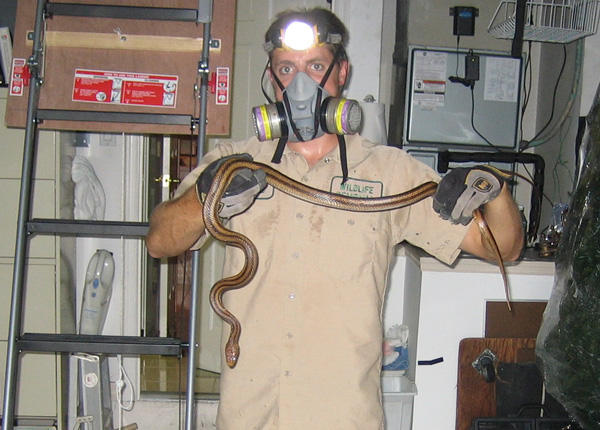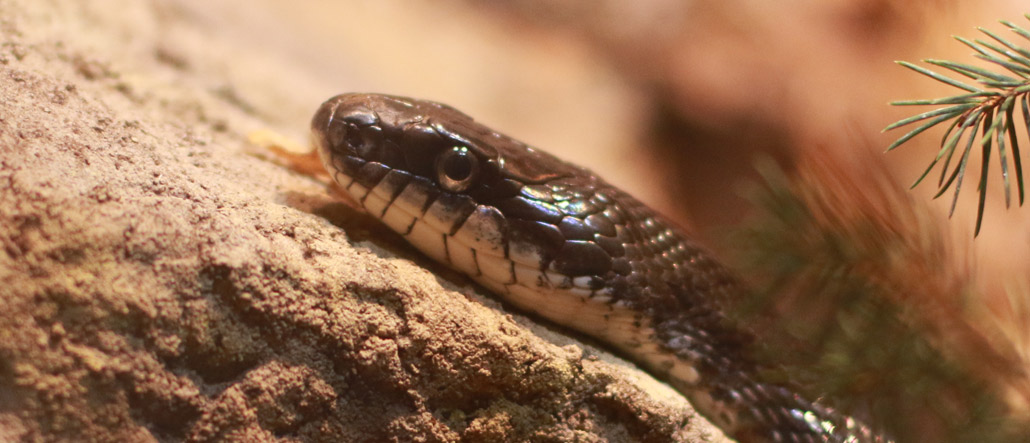- USA Wildlife Removal Education Guide and Resources
Snake In the Attic

How To Remove A Snake In The Attic - Snakes are normally considered to be ground dwelling animals, but there are actually many situations where a snake can climb different surfaces, and in some situations you will actually find a snake in the attic. These are usually likely to be lighter species of snake such as the Yellow Rat Snake, and in some cases it will often be a surprise for people to find that there are snakes living in their attic. It is important to be careful when dealing with snakes, as there are some species that can deliver nasty bites, while others are venomous and are even more dangerous to deal with.
There is one main reason that snakes will be found in an attic, and that is that they are being drawn there by a good food source, and in the majority of cases this will mean that there are rats up in the attic along with the snakes. There are very few examples of a snake infestation without the rodent infestation also being present, and in this case it will usually be as the snake has just finished devouring the rat population.
Removing The Food Source For The Snakes
In terms of dealing with a snake in the attic, it is also very important that you deal with the food source as well, otherwise you will find that other snakes are simply drawn to the attic by the presence of the rats. You can identify high traffic areas in the attic by the brown smudges of rat grease on the wall or on wooden beams, while the presence of rat feces will usually be a sign of the rat latrine. Snap traps are usually the easiest and best way of dealing with the rats, and set out several as there are likely to be quite a few rats present to attract the snakes.
Problems The Snakes Can Cause In An Attic
One of the major issues that can arise when snakes become loose in the attic is if they are there for an extended period, that a female can give birth to baby snakes, and if this happens those little snakes will be exploring the whole house. For those people who aren't aware of any animal infestation in the attic, if they do surprise a snake or accidentally corner the snake, then that can lead to a bite as the snake tries to defend itself.
Trapping And Removing The Snake
The first thing to note is that you should be very careful when setting traps and dealing with any trapped snakes, and avoid any opportunities to allow the snake to lunge at you. The best type of trap is a sticky trap, where the snake slithers on to a sticky pad, which then holds the snake in place, giving you an opportunity to remove and relocate the animal. In order to release the snake, you'll need to pour vegetable oil over the snake and the adhesive, which will then allow it to slither away.
Repair And Disinfect The Attic
Once you have dealt with the snake and any rats or other rodent that were caught in the trap, you will need to look to see if there are any repairs required. The reality is that snakes do not cause too much damage, but the presence of rodents mean you will often need to replace gnawed wires and also look to replace any soiled insulation material. Once the repairs are carried out, spray a disinfectant throughout the attic, and this will help to kill off any remaining bacteria or spores to make the area safe for people to enter again.
Top Tips For Preventing The Issue From Happening Again
- 1. Seal the attic to stop animals getting in - Look around the attic and look for any signs that would indicate how the rats and the snake was getting in and out of the attic. Ensure that these are repaired quickly and soundly, to ensure that the animals can't get in again. It is also worth checking the exterior thoroughly, as you may find that the animals had more than one entrance point.
- 2. Take measures to deal with any rodents quickly - If you find any signs around the interior or exterior of the property of pest animal activity, make sure that you act promptly and lay the appropriate traps to catch any rats. This will help to reduce the chances that the scent of rats in the attic will develop again, which is what attracted the snake to your attic.
- 3. Monitor your home for signs of snake or rodent activity regularly - Monitor your attic to see if you spot any signs of rodent activity in the future, and ensure that if you do spot signs that rats or snakes have found a way back into the attic, that they are dealt with quickly.
Go back to the main Snake Removal page for more information about dangers and signs of snake in the attic.
How to get rid of snakes in the attic: Snakes often invade the attic, especially in the winter months, when they search for places to get heat. Attics normally retain and maintain constant temperatures even during winter, and snakes often get heat through radiant sources because they can hardly generate heat within their bodies, these attics are some of the best options for snakes to get warm. Snakes are good climbers, they can crawl around all surfaces and enter the attic through crevices and cracks, and they can also enter at the points where shingles meet up with the gutters around the roof.

One of the best possible ways of getting rid of snakes from the attic is to use exclusion methods. Diverse species and types of snakes can find their ways into homes; they can navigate through the walls of homes, especially through interiors of walls. Holes in wall materials, especially pipes and wires can serve as entry points for snakes in the attic. Plumbers and architects must pay attention to minute construction jobs when handling minor installations. Aside from getting heat, snakes can invade attics for shelter and food.
Elimination of food sources for snakes is one of the first steps you can take to starve the reptiles and force them to abandon the attic. Secondly the use of snake traps can help you kill the animal, especially when you use bait, such as egg, or meat. Make sure the trap is perfectly hidden and unsuspecting, but the bait must be visible from afar, to lure the snake into the trap. You must have identified snake activities in the location where the trap will be placed. Lethal snake trap should be used to capture snake, because it can be dangerous to remove a snake that is captured alive.
Most snakes are active in the afternoon and return at dawn, thus you must install exclusion netting, when the animal has left the attic. Small snakes can enter through holes and crevices measuring ¼ inch, therefore you will have to spend more time to check out all entry and exit holes. If possible, you can make use of cement plasters to seal off crevices, or simply replace broken woods to ensure the animals don’t return. Do not make use of chemical poisons to get rid of snakes in the attic, because the environmental hazards created by their odour can be too strong for the entire house.

